
Step by Step Camper Winterization Guide
It's time to store your RV for the winter. Follow this guide to properly winterize and prepare your RV for long or short term storage.
Note: use RV/Marine antifreeze for the winterization of your RV. It is safe for fresh water plumbing.
If you would like a PDF version of this guide to print, click HERE.
Types of Anti-Freeze
- Automotive – Toxic, DO NOT USE
- Alcohol based – Generally regarded as non-toxic. Can dry out seals in fixtures and is prone to leaching- causing discoloration and fresh water odor. (Inexpensive and generally carried at big-box stores)
- Glycol based – Non-Toxic. Provides lubrication for seals and does not leach into lines or fixtures. (Moderately priced and generally available at RV dealerships)
How your water system works
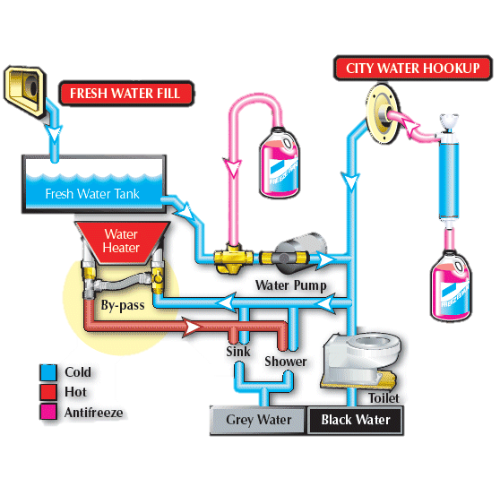 Let's begin by talking about how your RV water system works.
Let's begin by talking about how your RV water system works.
Your RV's water system draws water either from your fresh water tank and/or from the city water hookup. From the fresh water tank, a water pump is used to push water through the RV. (No pump is needed for water coming from the city hookup.) The water from the water tank and city water hookup will always be cold. To get hot water, the water must flow from your water pump into your water heater. The water is then heated and flows to your hot water fixtures such as sinks and shower. When winterizing your RV you will need to by-pass the water heater.
Winterizing Instructions
There are three methods to winterize your RV: Blow-out (risky), Anti-freeze (good), Combo Anti-freeze/Blow-out (best).
Before you start:
- Make sure to turn off all power to the water heater (the electric water heaters usually have their own power on-off switch).
- Make sure the water heater gas pilot is NOT lit.
Blow-out method (risky)
The blow-out method may fail during freezing temperatures due to the inability to completely remove all water in sensitive parts such as today’s modern toilet water valves.
- Disconnect the outside water source.
- Drain the water system. There should be up to three low-point drains. One for the cold water lines, one for the hot water lines and one for the fresh water tank. Open the petcocks to drain as much water from your pipes as possible. Open the water taps at all the faucets, showers and flush the toilet to drain any remaining water from the system.
- Drain Water Heater. On the outside of your water heater either remove the drain plug in the lower left had corner or open the drain valve in the same location. By leaving a faucet open on the hot water side, air will equalize pressure and easily drain the tank. You may want to use a bendable straw to put into the drain hole while water is coming out to create a siphon which drain all the water to the bottom of the rounded tank.
- By-pass your water heater. By-passing the water heater will allow the air pressure to more effectively push any moisture out of the lines. If using an Anti-freeze method, it can also save you money by not having to fill the water heater tank with as much as 6 to 10 gallons of anti-freeze. Many RVs come with a by-pass system pre-installed but some do not.
- Bypass hose. This is the simplest form of water heater bypass. Each time the water heater needs to be bypassed, the inlet and outlet water lines need to be disconnected from the rear of the water heater and connected together with the bypass hose.
- Three Valve System. This is the most commonly installed bypass system installed by the manufacturer. The three valve handles on the rear of the water heater will need to be orientated to bypass the water heater. The valves are open when the handle is in line with the water line and closed when the handle is perpendicular. For bypass operation, the top and bottom valves will need to be closed and the center valve will need to be opened.
- Two Valve System. The two valve handles on the rear of the water heater will need to be orientated to bypass the water heater. The three way valves pass water in the direction of the handle. For bypass operation, the top and bottom valve handles will need be in line with the bypass hose.
- Single Valve System. The valve handle on the rear of the water heater will need to be orientated to bypass the water heater. It will be located on the bottom (inlet) of the water heater. The three way valve passes water in the direction of the handle and a check valve installed on the hot water outlet prevents anti-freeze from entering through the outlet. For bypass operation, the valve handle will need be in line with the bypass hose.
- Docking Station Bypass System. These can vary significantly from brand to brand. In practice they are a 1,2 or 3 valve system that is more conveniently located. There should be labels or diagrams explaining the operation. If all else fails, consult your owner’s manual.
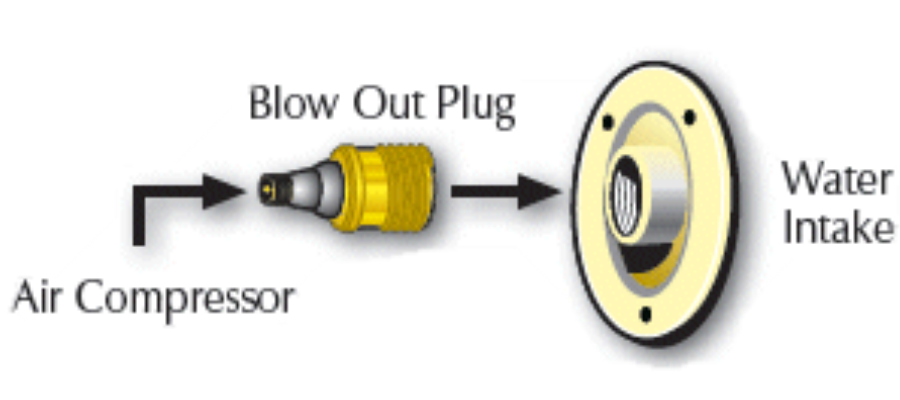 Blow out the lines. After draining as much water as possible, it is recommended that a blow-out plug be attached to the City Water Intake. Apply air pressure from an air compressor (not to exceed 45 PSI). Start by opening up one faucet at a time, starting from the furthest and working to the closest point to the city water inlet. Open the HOT side of the faucet ONLY. Allow all of the water to run out until only air is escaping. This will indicate that all water has been flushed from your system. Close the faucet. Repeat on the COLD side. Continue to the next closest fixture. Don't forget your toilet and outside shower if so equipped. Also, open the two low point lines for the HOT and COLD water lines to make sure no residual water that was pushed to the valves is trapped. Finally, close all faucets and the low point valves.
Blow out the lines. After draining as much water as possible, it is recommended that a blow-out plug be attached to the City Water Intake. Apply air pressure from an air compressor (not to exceed 45 PSI). Start by opening up one faucet at a time, starting from the furthest and working to the closest point to the city water inlet. Open the HOT side of the faucet ONLY. Allow all of the water to run out until only air is escaping. This will indicate that all water has been flushed from your system. Close the faucet. Repeat on the COLD side. Continue to the next closest fixture. Don't forget your toilet and outside shower if so equipped. Also, open the two low point lines for the HOT and COLD water lines to make sure no residual water that was pushed to the valves is trapped. Finally, close all faucets and the low point valves.
PRO-TIP: Closing the faucet for a few seconds and re-opening it will allow the compressor to catch up and may aid in removing additional moisture.- Pour at least 2 pints of anti-freeze into all sink and shower drains. The ice maker, washing machine and black tank flush will also need to be winterized. Look for this information in your appliance manuals.
- Drain and dump your gray and black water tanks. Remove battery, charge and store in a safe location.
Types of water heater bypasses

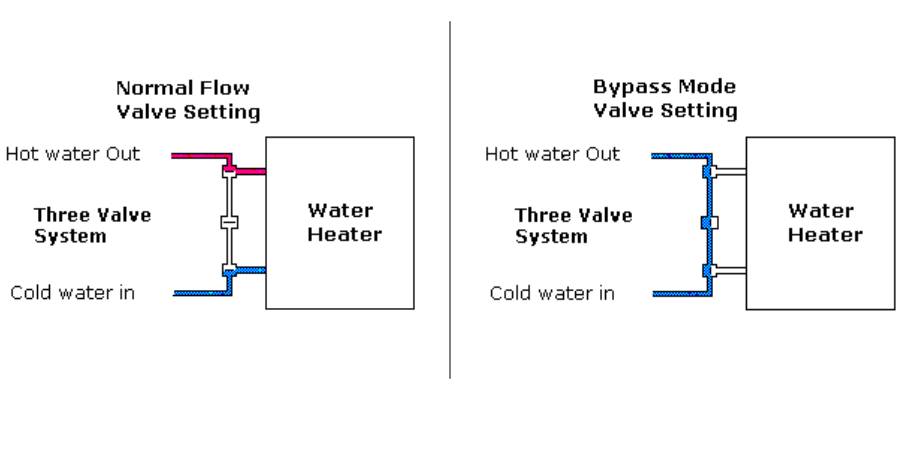
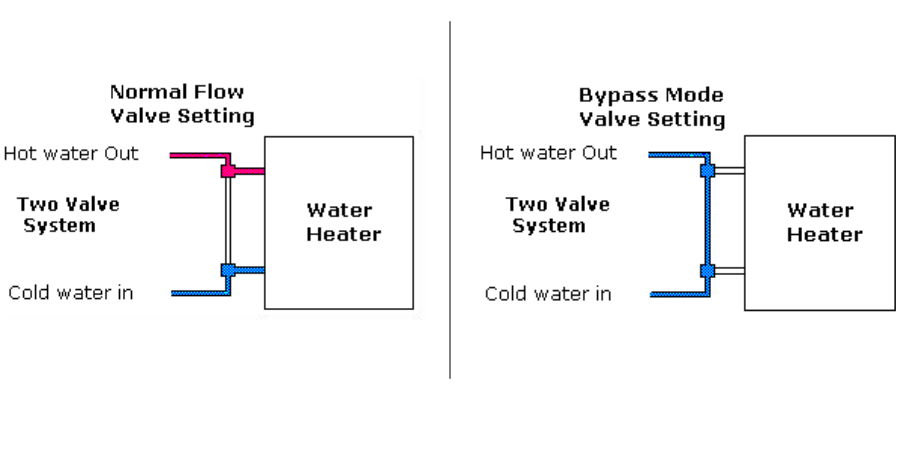
Anti-Freeze Method (good)
The anti-freeze method is the most recommended way of winterizing your water system. While failure of sensitive parts such as today’s modern toilet water valves may still occur at temperatures approaching the limit of the anti-freeze, following the tips in this method will provide the best protection.
- Complete steps 1-4 listed in the “Blow-Out Method”
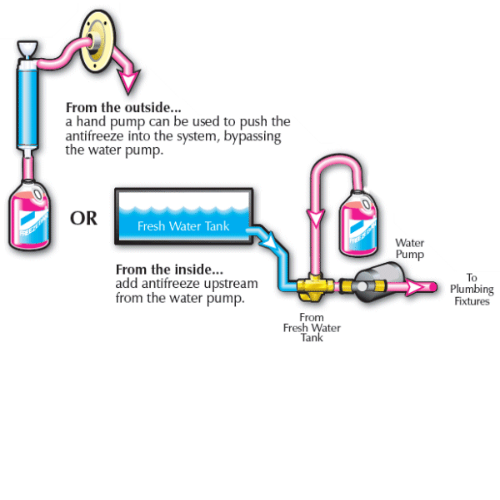 Add Anti-Freeze. You can add anti-freeze either from the inside using a Water Pump Conversion Kit or from the outside using a hand pump.
Add Anti-Freeze. You can add anti-freeze either from the inside using a Water Pump Conversion Kit or from the outside using a hand pump.
PRO-TIP: If your camper is equipped with a water filter, the filter will remove all of the pink color from the anti-freeze. The filter element can be removed or bypassed to prevent this. A replacement filter element will be required in the spring regardless. Be sure to check your progress by opening up one faucet at a time, starting from the furthest and working to the closest point to the water pump. Open the HOT side of the faucet ONLY. Pump anti-freeze until flow from the faucet becomes very pink. This will indicate that all water has been flushed from your system. Close the faucet. Repeat on the COLD side. Continue to the next closest fixture. Don't forget your toilet and outside shower if so equipped. Also, open the two low point lines for the HOT and COLD water lines to make sure anti-freeze gets to the valves and that no water is trapped. Finally, close all faucets and the low point valves.
** Note: If you use the hand pump from the outside method, remember to manually add antifreeze to your water pump OR if you use the water pump conversion kit method, remember to manually add antifreeze to the water line and the city water intake check valve (this is done by turning off the pump, removing pressure from the system by opening a faucet; then from the outside remove the screen at the city water intake and push in slightly on the check valve to purge any water from the line until pink anti-freeze comes out).**
PRO-TIP: Once pink anti-freeze reaches the toilet, operate the flush several times on and off. The surging of the anti-freeze within the water valve will help to dilute and flush any pockets of water out of the vulnerable housing and passageways.- Complete steps 6&7 listed in the “Blow-Out Method”
Combo Anti-Freeze/Blow-out (best)
The combo method will provide the protection that anti-freeze offers but does not require it to be left in the system for any significant length of time.
- Completely winterize using the “Anti-Freeze Method”
- Complete step 5 listed in the “Blow-Out Method”
- You are done winterizing. There are two options at this point.
- Leave the water heater bypassed until spring. You should reinsert the water heater drain plug to keep dirt, debris and insects out of the water heater. All you will need to do in the spring is run water into the system, flush any residual anti-freeze from your water lines and place your water heater back into normal operation.
- Prepare your camper for summer use by closing the low points, putting the water heater drain plug back in and place your water heater back into normal operation. In the spring, you will be able to use your water system as normal. Because there will be a small amount of residual anti-freeze left in the system, this option is best used when the fresh water system will not be used for consumption.
There will be nothing but air in your water system. Your water system will be protected without concern for foul tastes or discoloration. DO NOT ADD WATER UNTIL SPRING WHEN THERE IS NO CHANCE OF FREEZING.
Don’t Forget
- Remove any food that can spoil or attract mice from your RV.
- Clean storage areas, oven, range, refrigerator and areas around dinette.
- Examine seals around exterior doors and windows. Caulk if necessary.
- Check the roof for small leaks or other damage. Make repairs if necessary.
- Check plumbing vents, roof vents and air conditioner shroud.
- Disconnect your 120 volt line cord and store away.
- Add water to battery (if serviceable), charge, and disconnect battery cables.
- If possible, remove battery and store in a cool dry place. Cold weather will freeze a low battery.
- Clean and store your sewer hose.
- Replace bumper caps.
- Park with emergency brake on and use wheel chocks.
- Stabilize your RV. Make sure it does not rock when you walk inside it.
- Keep RV out of direct sunlight if possible.
- Now is a good time to wash and wax.
- Clean the awning. Do not use a dish detergent. They contain de-greasers which can cause your awning to dry out and crack. Use an awning cleaner that will clean, moisturize and remove mildew.
